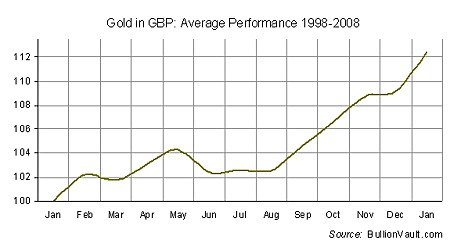Tap in to gold's yearly cycle
Each year for the last ten years gold has followed a remarkably consistent pattern. It rises in spring, slips back over summer and climbs sharply again in late-autumn. So is now the time for you to be buying?
This article was written for Whiskey and Gunpowder by Adrian Ash of BulliionVault
The sharp drop in world gold prices starting in late July knocked the cost of physical metal more than 20% off its record top of mid-March at last week's low point.
That level - just above $750 per ounce - also happens to sit right where the uptrend starting in September 2005 now lies. Meaning, for technical analysts at least, either a test (and perhaps collapse) of the bull market... or a screaming opportunity to buy gold on the cheap.
MoneyWeek
Subscribe to MoneyWeek today and get your first six magazine issues absolutely FREE

Sign up to Money Morning
Don't miss the latest investment and personal finances news, market analysis, plus money-saving tips with our free twice-daily newsletter
Don't miss the latest investment and personal finances news, market analysis, plus money-saving tips with our free twice-daily newsletter
Whichever way prices now move from here, however, it's worth considering the typical shape of a year in the life of the gold market:

As this chart shows - swapping the dollar for sterling, to remove the impact of the dollar's 30% drop on the foreign exchanges - the past ten years have seen the gold price follow a clear and regular pattern.
There have been exceptions, of course - most notably 2003 and 2006 - when the 'summer lull' that followed a sharp rise failed to match those high prices again by late-autumn.
But in the main, and with a near-tedious rhythm, the price of gold has risen in spring, slipped back or steadied in summer, and then enjoyed very much sharper gains once more, before the next year's really gets started.
CAVEAT INVESTOR: There are no guarantees this shape could be repeated this year. With the gold price falling so far, so fast, from its recent all-time record highs, sentiment among professional and institutional traders has clearly turned against the metal.
Gold buying by the world's no.1 buyers, meantime, has indeed collapsed, with imports to India dropping by 47% in the first half of 2008 from the same period last year. Indian gold buyers tend to account for the surge in physical buying seen during the autumn, as their festival season culminates in Diwali, the 'festival of lights'.
Diwali falls at the end of October this year. Reports out of India say the recent sharp falls in gold prices have already led to strong investment and jewellery demand. And here in the West, the economic background remains very bullish for gold - at least according to history.
US interest rates now lag inflation in the cost of living by more than 3%. A mountain of leveraged debt still teeters above Manhattan and the City of London. Government debt is rising worldwide, with a true 'monetisation' of bad loans at Freddie Mac and Fannie Mae now only a few weeks or months away.
If you thought about buying gold but were deterred by this spring's sudden high prices, it may be worth noting that the case for gold remains as it was. Too much debt, plus too much inflation, threatens to destroy the value of savings and wealth held in paper (whether in bonds, cash or equities). Physical gold, in sharp contrast, cannot be created at will. Owned outright - in your name alone - it's also no one else's liability or promise to pay.
Professional gold bars, stored securely and at very low cost in - say - Zurich, also represent one of the world's deepest and most liquid capital markets. That's simply not true of gold coins.
And it's worth noting, perhaps, that if the coin and small bar market can hit sudden supply problems like the current squeeze even as prices are falling, just what might become of liquidity - the ability to sell quickly for full value - when private investors come to sell en masse...?
Get the latest financial news, insights and expert analysis from our award-winning MoneyWeek team, to help you understand what really matters when it comes to your finances.
Adrian has written all things gold related from if it’s worth buying, what the real price of gold should be and what’s the point of gold for MoneyWeek. He has also written for other leading money titles on his gold expertise including Business Insider, Forbes, City A.M, Yahoo Finance and What Investment Magazine. Now Adrian is head of the research desk at BullionVault, a physical market for gold and silver for private investors online.
-
 Boost for over 100,000 families on Child Benefit as new HMRC payment system rolled out
Boost for over 100,000 families on Child Benefit as new HMRC payment system rolled outThousands of households will no longer have to pay the dreaded High Income Child Benefit Charge through self-assessment
-
 Are you being haunted by the ghost of Christmas past? How festive cutbacks could boost your long-term wealth
Are you being haunted by the ghost of Christmas past? How festive cutbacks could boost your long-term wealthThe average family spends around £1,000 over the Christmas season. Here’s how much you could have gained if you had invested some of the money instead.